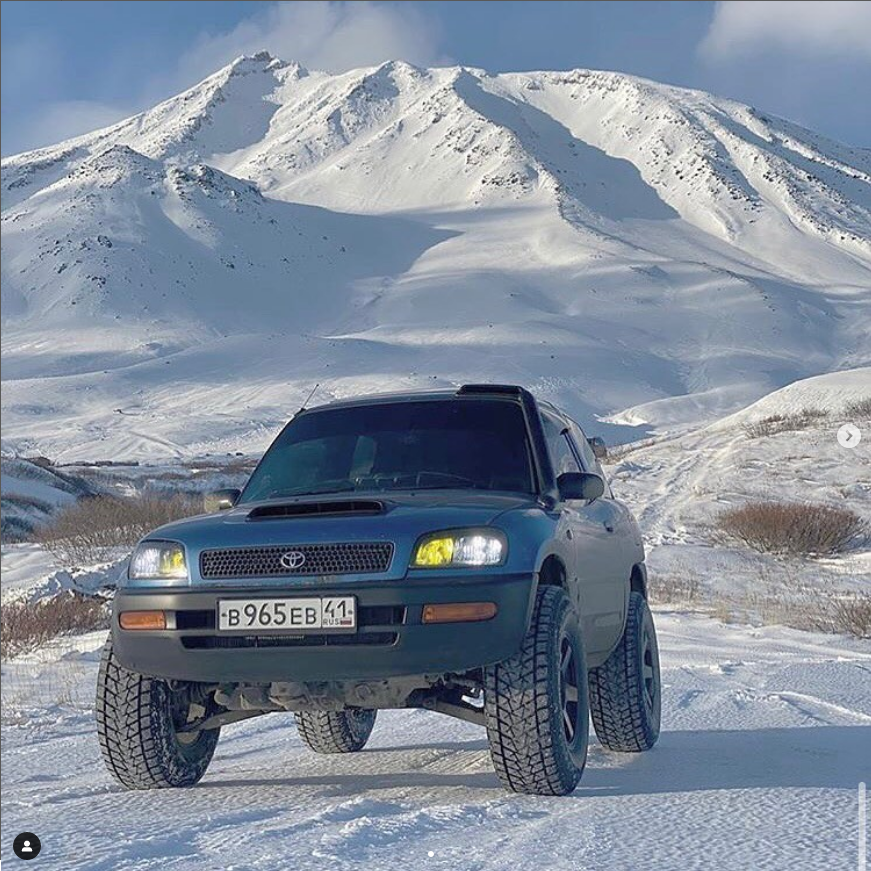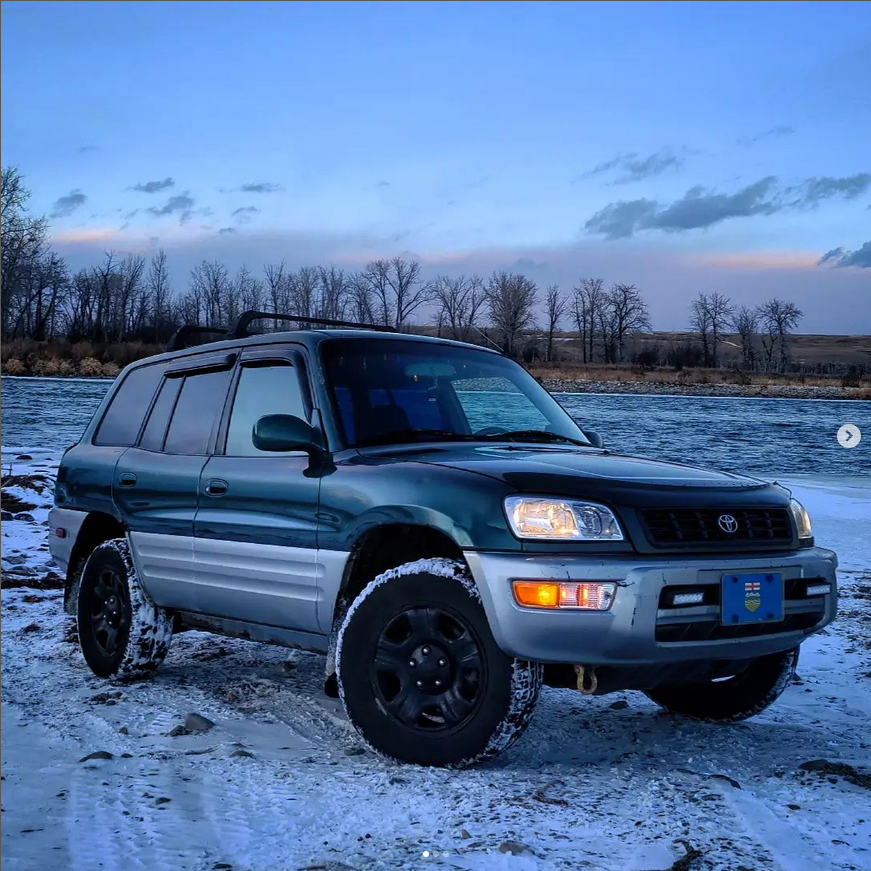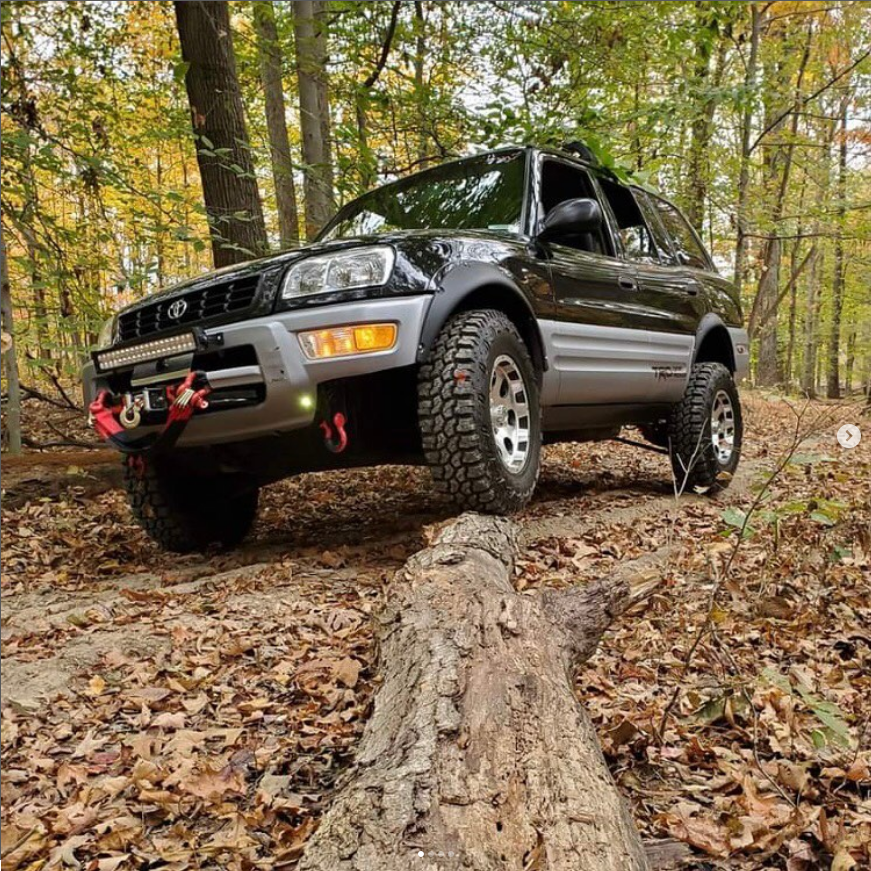1st Generation RAV4 (How Does It Perform Off-Road?)
The first-generation RAV4 is Toyota’s first small SUV. Produced from 1995 to 2000, it won over a large crowd with its unique look and compact size. But what about its ability to go off-road?
If you’re interested in this model for off-roading, keep reading for a complete breakdown of everything you need to know, from features and considerations to whether or not it’s the right choice for you.

Off-Road Capabilities
Off-roading is driving a car on unpaved areas like dirt, mud, sand, and rocks. Several categories determine if a vehicle is ideal for driving off-road, from 4WD to ground clearance.
Here are some of the features and specs that make the first-generation RAV4 stand out when the pavement stops:
- 4WD: RAV4’s power is sent to all four wheels, so you’ll have great traction and better control, which is perfect for off-roading.
- Torque and Horsepower: With 127 horsepower and 132 lb-ft of torque, the first-generation RAV4 has the power to get over tough terrain and hurdles off-road.
- Suspension: The RAV4’s four-wheel independent suspension gives it stability and control, making it a reliable choice in rough conditions. McPherson strut suspension in the front and double wishbone suspension with a trailing arm in the rear are the perfect combination when the vehicle is under stress.
- Differential: The five-speed manual version of the first-generation RAV4 has a central differential with a manual mechanical lock. This gives a ton of traction power whenever it’s required. Limited slip is essential for wheel rotation while off-roading, which is provided by the EC Hi-Matic system on four-speed automatic models.
- Ground Clearance: Most off-roading enthusiasts agree that the best ground clearance is between 8 and 10 inches. The first-generation RAV4 is adequate for handling challenging roads at around 7.5 inches.
- Approach and Departure Angles: Exact numbers are hard to come by, but off-road fans like myself usually say that for approach and departure angles, you should aim for at least 37 degrees, and a higher number is always better. With an approach angle between 37 and 39 degrees and a departure angle of 41-44 degrees, the first-generation RAV4 checks this box and more for a seamless off-roading experience.
(wikipedia, edmunds.com, rav4world.com, grid-offroad.com, jdpower.com, motorbiscuit.com)
Overland Capability
Overlanding is all about traveling to remote, off-the-grid locations and staying there. In other words, it’s basically a self-reliant car camping trip. If you’re planning overland travel, you’ll need to consider a few more factors on top of the off-road specs I broke down in the last section.
When it comes to overlanding, here’s how trustworthy the first-generation RAV4 can be in these key areas:
- Fuel Efficiency: Fuel efficiency is extremely important when you’re traveling remotely. It helps with trip planning by giving you an idea of how often you’ll need to stop for gas during your journey. The first-generation RAV4 has a fuel volume of 15.3 gallons and a fuel economy of about 21 mpg in the city and 27 mpg on the highway (23 combined), meaning you can drive about 350 miles before refueling.
- Towing Capacity: The first-generation RAV4 can pull up to 1,500 pounds. This is good information to know for an overlanding trip in case you need to tow a trailer for an extended stay.
- Reliability: The last thing you want to do on an overland adventure is get stuck in the middle of nowhere. Most RAV4s don’t have any known reliability issues, but remember that the first-gen model is an older vehicle, so many of the tech and safety features are outdated.
- Payload: Another important spec for overlanding is the payload. This will let you know how much weight your vehicle can carry to help you manage your storage and distribute cargo safely. The first-generation RAV4 has an impressive payload of 1,026 pounds.
(theadventureportal.com, edmunds.com, copilotsearch.com, overlandexpo.com, kbb.com)
Pros and Cons
Like any other vehicle, the first-generation RAV4 has a list of pros and cons to consider if you plan to take it on an off-roading adventure.
Pros
- 4×4 Advantage: The 4WD system on a first-generation RAV4 is made for off-roading, giving you better control and grip while driving across bumpy terrain.
- Suspension Support: The double wishbone suspension system makes the first-generation RAV4 stable and easy to move around off the pavement.
Cons
- Limited Ground Clearance: The RAV4’s stock ground clearance isn’t as high as it could be for the best off-road performance.
- Needs Modifications: Most of the time, lift kits and other changes are needed to fully use the RAV4 to off-road easily.
- Tech and Safety Gap: Since it’s a first-generation model, it doesn’t have as many modern safety and technology features as newer cars, which can be limiting.
Available Modifications
Although the first-generation RAV4 is great for off-roading, there are some additional modifications that may enhance your vehicle for off-roading or overlanding. Here are some of my suggestions and product recommendations that may work for you.
Lift Kit
A lift kit is a suspension upgrade that makes your RAV4 sit higher off the ground. With a higher profile, you can more easily navigate through obstacles that would challenge a shorter vehicle.
When you install a lift kit, you get increased approach, departure, and breakover angles. This helps when driving through uneven trails, deep water crossings, or climbing steep inclines.
Not only is it a game-changer when it comes to flying over difficult territory easily, but it also makes room for larger tires if you’re considering that upgrade as well.
Roof Rack
A roof rack is a set of bars you attach to the top of your car, giving you more room to store large items like luggage, tents, and outdoor gear for off-roading.
You’ll also enjoy more room when you’re inside the vehicle since you won’t need to use any indoor storage space. This is especially helpful for RAV4 owners since the vehicle is compact.
Consider these Rhino Rack Vortex Aero Crossbars for the 2000 RAV4, which are made of black aluminum and extend to 46 inches long. For old 1st gen RAV4s, take a look at this roof rack system from Paw, which secures with a metal lock and is easy to mount.
(wikipedia.org, apexoverland.com)
Bigger Off-Road Tires
Upgrading to larger off-road tires can improve your vehicle’s grip and ground clearance. This will help you avoid slipping and easily pass through rough terrain.
You can also drive on mud and soft surfaces without compromising performance. With more control of your vehicle, you can confidently take on rugged trails in your RAV4.
The Nitto Ridge Grappler tires are a solid option if you’re looking for heavy-duty spiral-wound tires. They also have a hybrid tread design for a quiet drive and a 500 treadwear rating.
The Falken Wildpeak A/T Trail is another great tire. This was what I chose for my 2021 RAV4, but it’s also a great choice for a 1st-gen off-roader. These will give your RAV4 a tread depth of 10” and a speed capability of up to 130 mph. The rim diameter of these tires is at a perfect 16 inches for increased off-road durability.
Exhaust System
Off-road exhaust systems that aren’t made by the manufacturer last longer and let more air through. They usually have more durable materials (like stainless steel) to help your vehicle survive against rocks and rust.
If your current exhaust system is already rusted and falling apart, consider a new system before heading out on the trails.
(theengineblock.com, autodeal.com)
Build Photos
Here are a few photos of first-generation RAV4 off-road builds to give you some inspiration.








Thoughts From RAV4 Owners
The general consensus from RAV4 owners online is that the vehicle can be good for off-roading but could use some improvements in certain areas.
On the rav4world forum, tinmanchris217 mentioned, “the first-generation RAV4 has sturdy suspension parts that are mostly tucked in, which makes it a “decent platform for off-roading.”
Sean Dias on Quora somewhat agrees, stating the first-generation RAV4 with 4WD is “somewhat capable but not good by any means.” He goes on to say that getting to your destination in bad conditions is possible with a few modifications.
Finally, user MR2turbo4evr posted on Reddit that his “98 5-speed manual had a ‘decently low’ first gear, but it’s not the best choice for ‘serious off-roading’ overall.”
Maintenance and Care
Keeping your first-gen RAV4 in top shape after off-road adventures takes work. Here are some tips from an experienced owner:
- Maintenance: Keep up with routine maintenance and do complete checks after every off-road trip.
- Cleaning: Keep your RAV4 clean so that mud, dirt, and other things that could slow it down don’t build up.
- Components: Check your tires, suspension parts, wheels, and shocks for signs of wear and damage regularly.
- Engine and Fluids: After you go off-roading, check your engine and fluids to ensure everything is in good shape.
Expert Tip
Coming from a first-generation RAV4 owner and fan of off-roading, my best advice is to learn the limits of your vehicle by starting with less difficult territory. With practice, you can improve your skills and learn the power of your RAV4, allowing you to work your way up to bumpier trails.
Frequently Asked Questions
Exploring the Off-Road World
The first-generation RAV4 is a flexible vehicle and a solid choice for people who like to go off-roading. Some of its best features are its 4WD capabilities and ideal approach and departure angles. However, the first-gen model is an older vehicle, so you should be okay with adding your own modifications to get the most out of your off-road driving or overlanding experience.
If you choose a first-gen RAV4, you’ll have the best results if you figure out what your vehicle can do in a safe setting and avoid pushing it past its limits.
